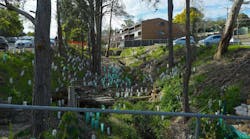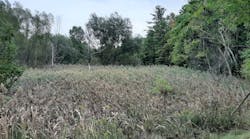Cleaning sewers, removing roadkill from highways, and gutting catfish certainly qualify as dirty jobs, but the folks at San Marcos, CA’s Hydro-Plant found they were in that category, too, when the Discovery Channel recently filmed a Dirty Jobs With Mike Rowe episode with the company.
“Gary [Weems, the owner] was interviewed by a freelance magazine writer, who knew someone who worked on Dirty Jobs. He told them about Hydro-Plant,” says Dale Weems, hydroseeding foreman. “Application is the dirty part of our business-spraying in the wind, you can get covered in mulch-and when it rains, getting your feet muddy is just part of the job.”
The 40-year-old company services a large portion of the country. “Our company will go anywhere we need to go. I’ve been to South Dakota, Mexico, Hawaii, and Nevada,” Weems says. However, Hydro-Plant chose a project in Chula Vista, CA, to feature on the Discovery Channel program. “We had a job at Otay Ranch, a master-planned community that includes commercial property. The developer is building little neighborhoods with parks and shops. The site contained a 5- to 6-acre slope, which we needed to stabilize; during the show, we only touched a little of it. We put down 9,000 gallons of material, which covers approximately 45,000 square feet of area, during the eight-hour shoot. Alone, without shooting the TV show, we could have done the project in about half a day.”
Even though just a portion of the job was completed during the show’s filming, three trips with the company’s Bowie hydroseeding machine were required. Weems explains, “Each truck holds 3,000 gallons, which covers approximately 15,000 square feet. That day, we applied a slurry of wood fiber mulch and guar-you could think of it as adding “˜glue’ to the site. Our absorbent gelling material keeps it moist, and also mulch absorbs the water sprayed during the application. There was no seed in the slurry; this was strictly an erosion control procedure. We’ll seed the site three to six months later.”
The Hydro-Plant crew-Weems and employee Gino Selvaggio-put Rowe to work; their everyday tasks gave the TV host a workout. “A lot of pressure travels through the hydroseeding hose. Rowe had to pull the hose up a 300-foot hill. He said, “˜I don’t ever want to do that again!'” However, Weems found Rowe to be a good potential employee. “Mike Rowe is a fast study. Hosting his TV show is an interesting job; he has to come out on a project and figure out not only how to do it but also how to explain it to his audience, to make it entertaining. Rowe has to add some showmanship for the TV—for example, he’d say, “˜Oh, I’m not supposed to do this,’ and he’d spray the truck rail, to show people why not.”
His stint with Hydro-Plant is just one of the many dirty jobs Mike Rowe has made interesting. In previous show episodes, he has cleaned up toxic bird feces, dived for golf balls in alligator-infested waters, and assisted in artificially inseminating a horse-to mention just a few of the curious, dirty, and sometimes dangerous professions he’s explored. Before his Dirty Jobs role, Rowe appeared in other Discovery Channel programs, including Egypt Week Live! and Deadliest Catch, a series investigating Alaskan crab fishing, a profession considered by some to be the world’s most dangerous.
The show aired seven times in March. “Did we enjoy it? Yes. It was wonderful,” Weems says. “We got Mike Rowe dirty, and he got me dirty, too!”

